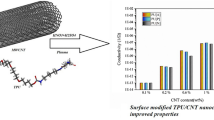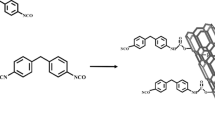Abstract
Novel hybrid inorganic/organic poly[cyclotriphosphazene-co-(hexafluoroisopropylidene)] nanotubes (PZTs) were synthesized through nucleophilic substitution using one-step method. The surface of PZTs contains hydroxyl and fluorine groups with a ratio of approximately 1:3, which imparts many functional properties to the nanotubes. The introduction of the active hydroxyl groups increased the chemical bond crosslinking between the nanotubes and the matrix resin. The introduction of fluorine atom provided the hydrophobicity and abrasion resistance properties. The water contact angle of PZTs is 140.3°. Chemical reaction occurred between WPU and PZTs to form covalent bonds through in situ polymerization. The water contact angle and thermal stability of waterborne polyurethane (WPU)/PZTs increased with the increasing nanotube content. When the nanotube content was 1.0 wt%, the maximum tensile strength of the composites was 3.36 MPa and the maximum elongation-at-break was 446.8%. The nanotubes showed toughening and strengthening characteristics. When 1.0 wt% PZTs were incorporated, the friction coefficient and abrasion loss of the composites reached a minimum value. The addition of nanotubes could increase surface hardness and crosslinking degree, absorb the coating heat of friction, and reduce the adhesive wear of polymer and the wear amount. The introduction of fluorine atoms could form a chemical transfer membrane and reduce the friction coefficient. Polyphosphazene nanotubes showed excellent modification properties in the waterborne polyurethane system.







Similar content being viewed by others
References
Liu R, Shan ZH (2018) Research for waterborne polyurethane/composites with heat transfer performance: a review. Polym Bull 75:4823–4836
Akram N, Zia KM, Saeed M, Usman M, Khan WG, Bashir MA (2019) Investigation of non-adhesive behaviour of waterborne polyurethane dispersions. J Polym Res 26:78–86
Zhao H, Zhao SQ, Hu GH (2019) Synthesis and characterization of waterborne polyurethane/polyhedral oligomeric silsesquioxane composites with low dielectric constants. Polym Adv Technol 30:2313–2320
Li R, Shan Z (2018) Asynchronous synthesis method of waterborne polyurethane with the differences of structural features and thermal conductivity. J Polym Res 25:2129–2138
Tafazoli S, Rafiemenzelat F, Hassanzadeh F, Rostami M (2018) Synthesis and characterization of novel biodegradable water dispersed poly(ether-urethane)s and their MWCNT-AS nanocomposites functionalized with aspartic acid as dispersing agent. Iran Polym J 27:755–774
Naghash HJ, Abili B (2019) Synthesis of a silicone containing allylic monomer and its uses in the waterborne polyurethane/vinyl acetate-acrylic hybrid emulsion copolymers. Prog Org Coat 133:424–424
Fang CQ, Pan SF, Wang Z (2019) Synthesis of waterborne polyurethane using snow as dispersant: structures and properties controlled by polyols utilization. J Mater Sci Technol 35:1491–1498
Zia KM, Bhatti HN, Bhatti IA (2007) Methods for polyurethane and polyurethane composites, recycling and recovery: a review. React Funct Polym 67:675–692
Zhao ZP, Pan CY, Hu JJ, Jiang GJ, Zhong MQ, Fei BH (2018) Properties of waterborne polyurethane filled with fluorinated polyphosphazene microspheres in situ polymerization. Sci Adv Mater 10:1073–1082
Zhao ZP, Ji JB (2014) Synthesis and tribological behaviors of epoxy/phosphazene-microspheres coatings under dry sliding condition. Adv Eng Mater 16:988–995
Pan TJ, Huang XB, Wei H, Wei W, Tang XZ (2012) Intrinsically fluorescent microspheres with superior thermal stability and broad ultraviolet-Visible absorption based on hybrid polyphosphazene material. Macromol Chem Phys 213:1590–1595
Chen KY, Huang XB, Wei H, Tang XZ (2013) Fabrication of core/shell structured NaYF4:Yb3+, Er3+/polyphosphazene upconversion nanophosphors functionalized with abundant active amino groups. Mater Lett 101:54–56
Zhu L, Xu Y, Yuan W, Xi J, Huang X, Tang X, Zheng S (2006) One-pot synthesis of poly(cyclotriphosphazene-co-4,4'-sulfonyldiphenol) nanotubes via an in situ template approach. Adv Mater 18:2997–3000
Wei W, Huang XB, Zhao XL, Zhang P, Tang XZ (2010) A rapid and efficient strategy for preparation of super-hydrophobic surface with cross-linked cyclotriphosphazene/6F-bisphenol A copolymer microspheres. Chem Commun 46:487–489
Hu Y, Meng LJ, Niu LY, Lu QH (2013) Janus photonic crystal microspheres: centrifugation-assisted generation and reversible optical property. Langmuir 29:915–9163
Li ZK, Wang LC, Zhang AQ (2015) Synthesis of cyclotriphosphazene-containing polymeric nanotubes and their use as metal-free photocatalysts for methylene blue degradation. Appl Surf Sci 347:541–547
Sun LJ, Liu TH, Li H, Yang L, Meng LJ, Lu QH, Long JG (2015) Fluorescent and cross-linked organic-inorganic hybrid nanoshells for monitoring drug delivery. ACS Appl Mater Interface 7:4990–4997
Chang FQ, Huang XB, Wei H, Chen KY, Shan CC, Tang XZ (2014) Intrinsically fluorescent hollow spheres based on organic-inorganic hybrid polyphosphazene material: synthesis and application in drug release. Mater Lett 125:128–131
Hu Y, Meng LJ, Lu QH (2014) “Fastening” porphyrin in highly cross-linked polyphosphazene hybrid nanoparticles: powerful red fluorescent probe for detecting mercury ion. Langmuir 30:4458–4464
Kim HS, Noh ST (2009) Preparation and properties of polyurethane dispersions with aromatic/aliphatic mixed diisocyanate. Appl Chem Eng 20:258–265
Hu L, Zhang AQ, Yu Y, Zheng Z, Du SX, Chen XJ (2014) Synthesis of hybrid crosslinked polyphosphazenes and investigation of their properties. Iran Polym J 23:689–698
Honarkar H, Rahimi A (2007) Applications of inorganic polymeric materials, III: polyphosphazenes. Monatsh Chem 138:923–933
Mathew D, Nair CPR, Ninan KN (2000) Phosphazene–triazine cyclomatrix network polymers: some aspects of synthesis, thermal-and flame-retardant characteristics. Polym Int 49:48–56
Acknowledgements
We are thankful for the valuable support from Keqiao Innovation Research Institute of Zhejiang University of Technology (2018KQ002), Zhejiang Provincial Natural Science Foundation of China (LY18E030009, LQ14E030004, LQ18E030013) and National Natural Science Foundation of China (21504079, 31370563).
Author information
Authors and Affiliations
Corresponding author
Rights and permissions
About this article
Cite this article
Zhao, Z., Zheng, W., Chen, G. et al. Polyphosphazene nanotube and modified waterborne polyurethane prepared by in situ polymerization. Iran Polym J 29, 493–500 (2020). https://doi.org/10.1007/s13726-020-00813-9
Received:
Accepted:
Published:
Issue Date:
DOI: https://doi.org/10.1007/s13726-020-00813-9




